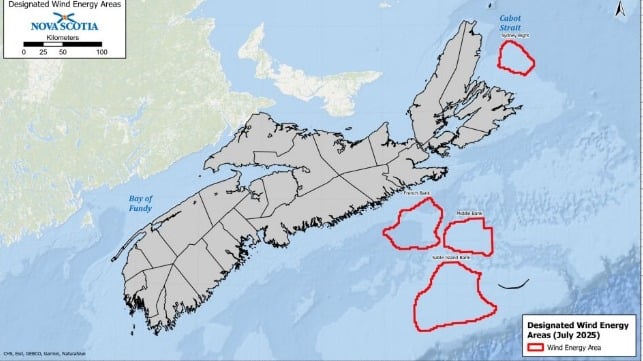Canada Designates First Zones for Offshore Wind Energy off Nova Scotia

After extensive exploration, the Canadian federal government and the Province of Nova Scotia took the first definitive steps for the development of Canada’s offshore wind energy industry. Calling it a “key step,” the local and federal government jointly presented the first four zones to be made available for development in a call for bids expected by the end of the year.
Nova Scotia’s Premier, Tim Houston, has a bold vision for the industry and creating a new business for Canada’s eastern province. While Nova Scotia currently has peak electrical usage of approximately 2.4 GW of power, Houston wants to make Nova Scotia into an ”energy superpower.” He predicts the industry could grow to a generation capacity of 40 to 50 GW, making it an energy exporter. It might even benefit from Donald Trump’s avowed stance to stop wind power, as there have been reports that Massachusetts might become a power importer from Canada to make up for the loss of its plans for offshore wind power energy.
“With some of the top wind speeds in the world, Nova Scotia has the potential to become a clean energy superpower,” said Premier Tim Houston. “With the right infrastructure, we’ll have the opportunity to send our wind west to power other parts of Canada. By becoming an energy exporter, we can secure long-term prosperity for Nova Scotians.”
A total of four areas were released in today’s plan, three to the east of Nova Scotia and one to the north. Three (Middle Bank, Sable Island Bank, and Sydney Bight) would each be at least 25 kilometers (15 miles) from shore and are at depth for fixed-bottom turbines. The fourth, French Bank, would be closer at 20 kilometers (12.5 miles), and that was done on purpose because the waters are significantly deeper, meaning it could require floating turbines, but the distance is designed to ensure that it remains economical.
Houston told the audience during a press event that the province has great potential and the industry could become an economic driver for Nova Scotia. He noted that some companies are already using Nova Scotia as a staging area for offshore wind projects.
The government said the first call for bids would be for a modest 2.5 GW and would be followed by additional rounds. The goal is to license 5 GW by 2030. After designating the location, the government will now direct the Canada-Nova Scotia Offshore Energy Regulator to begin preparing the bidding process.
After the first round of licenses is awarded, four other areas identified in the January 2025 regional assessment of offshore wind development will be revisited. They include Western/Emerald Bank, which was originally included as the fifth area in the announcement in the spring. Government officials said it has been delayed due to the complexities of the site and feedback during the public comment period.
